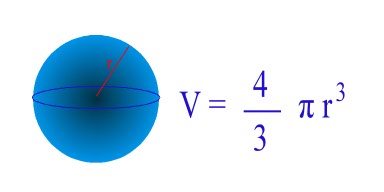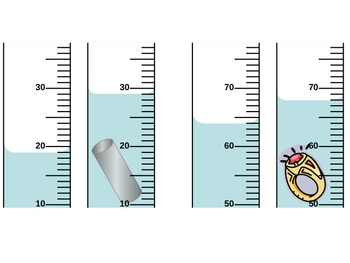LAB #6
– Measurement: Volume
Introduction
Volume
is the amount of space occupied by matter - solid, liquid, or gas.
Volume is measured in
units: cm3 for a solid, mL for a liquid.
Problem
-
A:
How can we find the volume of a rectangular block?
-
B:
How can we find the volume of an irregularly
shaped object?
Hypothesis:
-
Materials
-
Various
sized blocks, irregular shaped objects, ruler, graduated cylinder
Procedure A
1) Use a metric ruler to measure the
dimensions of your rectangular objects; measure to the nearest tenth (0.1) cm.
2) Calculate the volume in cm3 of your rectangular object by multiplying the length (cm) times the width (cm) times the height (cm). V = L x W x H
3) Record your measurements in the data table.
2) Calculate the volume in cm3 of your rectangular object by multiplying the length (cm) times the width (cm) times the height (cm). V = L x W x H
3) Record your measurements in the data table.
Results
Data
Table: Volume of rectangular objects
Object
|
length (cm)
|
width (cm)
|
height (cm)
|
Volume (cm3)
|
A
|
||||
B
|
||||
C
|
||||
D
|
V
= L x W x H
cm3
= (cm)(cm)(cm)
Procedure B
Use a graduated cylinder to measure
the volume of an irregular shaped solid.
1. Fill the graduated cylinder to 50 mL and record this into your notebook. This is your initial volume.
2. Carefully drop the object in on an angle. The object will displace water (push water up to make way for the object) which will rise to make a new volume.
3. Subtract your initial volume from the new water level.
New Volume --------------à _____mL
Initial Volume ------------à _____mL
Volume of irregularly shaped object: _____mL
Volume of sphere using equation:_____cm3
Analysis
1) What is the maximum volume you can measure with this
graduated cylinder?
2) What is the smallest volume you can measure with this
graduated cylinder?
3) Determine the
value of the minor grids on the cylinder.
i.e. how many mL does each line equal?
4) If you had a large enough sized graduated cylinder, could you use it to measure the volume of your blocks? What problems may you encounter when trying this?
5) Define "displacement" in your own words.
6) What are the volumes of the following objects? (Don't for get units!)
a. silver cylinder = ______
b. ring = ______
c. fish = ______
d. rock = ______
Conclusion
What
was your problem?
|
Restate
your hypothesis. Was it right? wrong? why or why not?
|
What
did you learn in this lab?
|
What
did you like about this lab?
|
What
were some challenges you had to deal with?
|
What
could you do next with this problem? What other tests could you
perform?
|
Write
down any other additional thoughts, observations, inferences, etc.
|
Complete the following worksheet in your lab workbooks:









